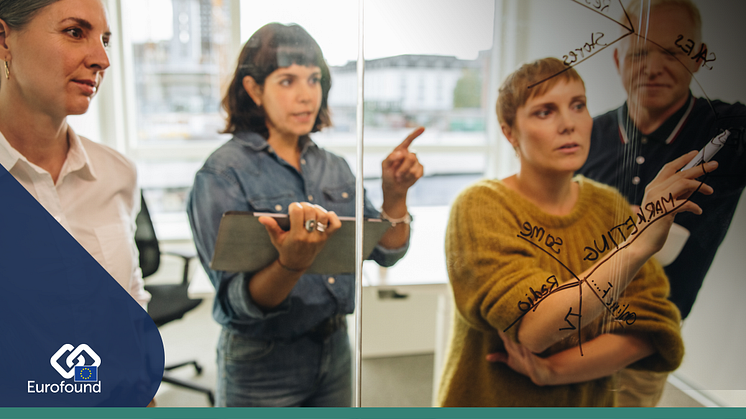
Blog post -
What can companies do to spark innovation in the workplace?
Blog by Stavroula Demetriades
As we leave behind the lockdowns and business disruptions of COVID-19 and enter a ‘new normal’, it is time to talk about how workplaces might be transformed to drive innovation. Some may baulk at this suggestion, as we continue to grapple with the pandemic fallout, but crises have always been a cradle for change, creating a space to reflect on the things that are not working and to find solutions to them. Innovation is critical now as Europe faces into the transition to a green and digital economy. Businesses will have to develop processes, products and business models that are compatible with a climate-neutral future. They will have to digitalise across their operations and outputs, and do so fast to stay abreast of the competition.
One in five European companies introduced an innovation to the market in the three years between 2016 and 2019, according to the European Company Survey (ECS) 2019, and these were more likely to be young companies or large companies. This suggests that the large number of small and medium-sized enterprises (SMEs) across Europe could be doing more to introduce new products or services in their markets. In fact, they put themselves at risk by staying still. As one manager interviewed for a follow-up study put it, ‘You cannot really say, “I am well positioned here in my market, so I am staying where I am today.” If you do say that, then one day … you will be forced to close down.’
What can companies do to boost their innovation efforts? Those keen to innovate usually and rightly consider their investments in R&D, patents and commercialisation of their products and services, but many fail to think about their workplaces and how their approach to managing employees might also be a basis for innovation. Eurofound surveyed over 20,000 managers in European companies for the ECS 2019, and analysis of their responses revealed that the companies most likely to introduce innovation to the market are those that take a people-centred approach to management. We followed up the survey with in-depth interviews of managers and employees of innovative companies to investigate what they had to say about the implementation of people-centred practices. Distilling the findings from both, we came up with five workplace practices typically seen in innovative companies – described below, with examples from the follow-up study.
1. Design jobs that are challenging and give autonomy to employees
Companies whose management facilitates employees to work independently, solve problems and organise their own work schedule are more likely to introduce market innovations than companies that closely control and monitor their employees. Innovative workplaces are also typically run by teams that organise themselves and their work.
For one of the companies included in the follow-up study, a software design company, innovation is rooted in employee autonomy. The company has no defined innovation roles as ‘innovation is everyone’s domain’, in the words of one interviewee. Solutions are employee-driven, where workers approach problems by asking themselves, ‘Can this be done better?’ Workers are given the freedom to explore and experiment with new ideas (but within the limits of the time and resources available).
2. Have high expectations of employees but motivate them too
Innovative companies expect their employees to do more than the tasks a narrow job definition would ask. It is important to them that employees are committed and show it by helping each other, staying at work longer if needed and making suggestions for improvements to the business.
But these companies also recognise that they need to motivate such behaviour, and they take a multipronged approach to motivation – by offering opportunities for training and development, by endeavouring to make the work interesting and stimulating, by rewarding performance, and by having a strong mission and vision that employees can share.
Speaking with managers of a pharmaceutical company, we observed that training is at the core of their approach to motivating employees. The HR manager remarked, ‘We in HR sometimes say we cannot find the right skills, but we also need to develop the technical skills required.’ As well as providing formal training delivered by external providers, the company encourages its employees to propose other training and development opportunities; ‘This is more important than us guiding them to the “right” path’, the HR manager explained. The company also encourages employees to acquire new knowledge by approving their participation in scientific and research events.
3. Reward performance
Monetary incentives play a role. Innovative companies typically reward employees with extra pay using reward systems linked to individual or group performance, offering payment by results or implementing profit-sharing schemes.
Talking with managers of various innovative companies active in engineering, furniture design, aluminium products and services, we found several approaches to rewarding employees who come up with innovative ideas. For instance, one company gives employees whose ideas have been implemented a once-off proportion of the profit. They can also receive extra pay cheques, vouchers or other benefits, such as family trips. Another practice is to reward an employee proposal that leads to the company making savings by paying the employee some of those savings.
4. Involve staff in decision-making
Innovative companies value employee input to management decision-making. They hold regular meetings in which employees participate and influence management decisions. These companies recognise that employee involvement gives them a competitive advantage, even if it might cause some delay in the implementation of changes.
This type of employee input is illustrated by a service company in our study, where employees can pitch suggestions for new projects and typically participate in the follow-up meetings where these ideas are assessed. They are also empowered to make decisions at the implementation stage: ‘I have full control of the project’, noted the employee we interviewed. Employee suggestions for changes in the production process (involving new technologies, materials or new business intelligence) are particularly welcome.
5. Collaborate with other companies and organisations
Finally, collaborating with other organisations is important. Working with suppliers, partners, other companies and research centres can help to formulate and define the problem to be solved, while access to external expertise and technical solutions expands companies’ knowledge base.
Managers and employees of an engineering company we interviewed told us how they organised their practices to address the pandemic challenge in collaboration with a university. The COVID-19 crisis and the massive need for personal protective equipment (PPE) prompted employees to work with a university to develop a protective face mask, which went into mass production within a month.
Investing in people-centred practices for innovation in the post-pandemic era
The pandemic has seen crisis-induced innovation by some companies, which tested new solutions to new problems to deal with uncertainty. As companies look to the future in the wake of the pandemic, they may be pondering the allocation of resources, new business opportunities and the use of innovation for growth. Investments in R&D and technologies to expand digitalisation and enhance the green transformation of their products and services could bring them dividends.
Organisations need to remember, however, that people-centred practices are important factors in innovation, as our research shows. Developing and making better use of their human capital to solve new problems and provide new solutions to the market is urgent. It is now that they need to recruit people who love learning new things, to give them the time and space to experiment, and to involve them in deciding strategy and direction. It is now that they can invest in well-designed jobs that give autonomy to people and stimulate innovation. If not now, then when?
Download the publication:



